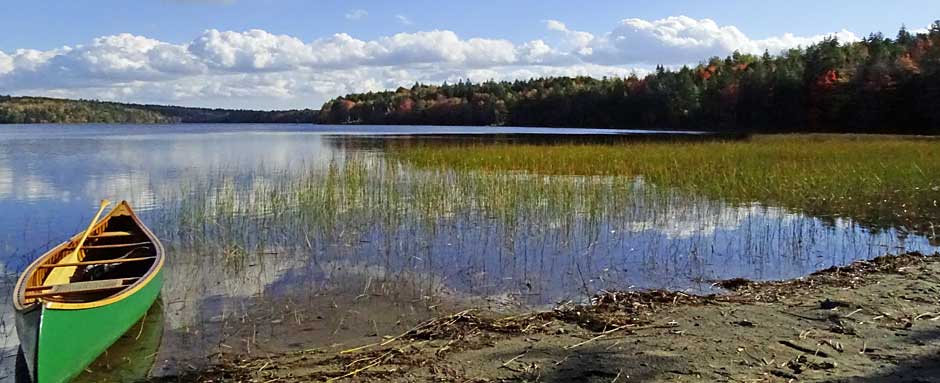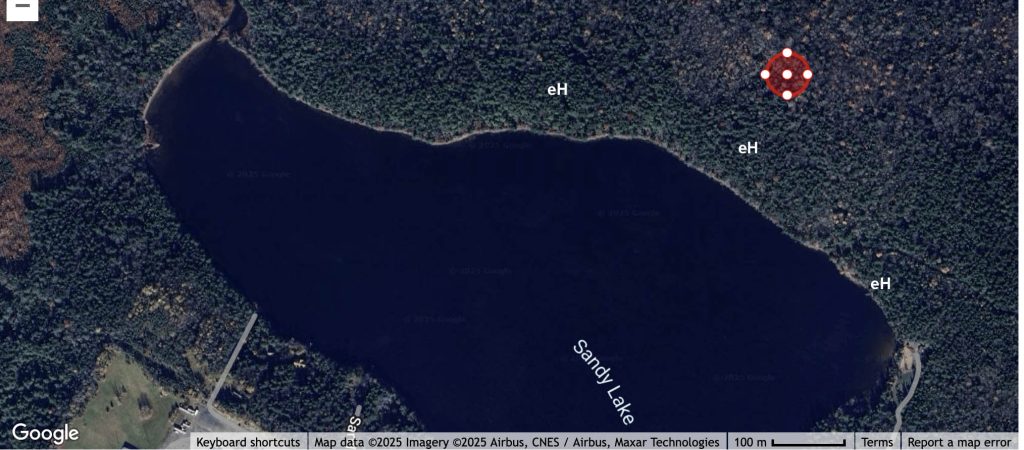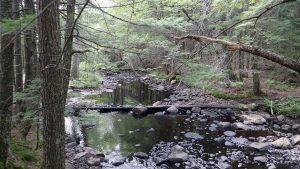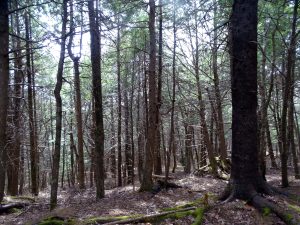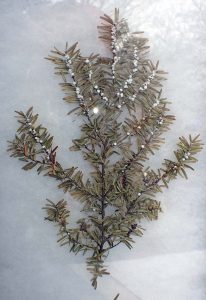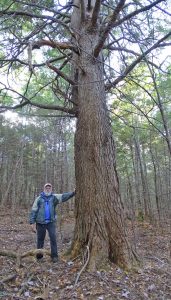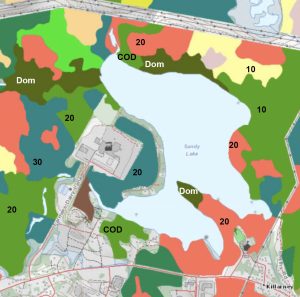
Occurrence of hemlock in the immediate vicinity of Sandy Lake (Bedford). Adapted from DNR Leading Species layer https://versicolor.ca/slbfiles/maps/dnrmaps/ForLeadingSpp.jpgon Provincial Landscape Viewer. Dom: Hemlock dominant. Nos. are approx percentages of hemlock in stands dominated by other species, as given in Forest Stand Details layer. Click on image for larger version.
Hemlock, specifically the Eastern Hemlock, (Tsuga canadensis), is a prominent species in forests of Sandy Lake & Environs.
It is the dominant tree species in three stands in the immediate vicinity of Sandy Lake, and it’s a significant component in most of the other forest stands (view map at right).
Hemlocks in the cathedral-like “Peninsula Hemlock Stand” are over 200 years old, while patches of Old Growth circa 145 years old occur in the hemlock dominated stands on the north and west sides of Sandy Lake.

“This map displays detection sites as of January 2025.” Screen capture of map posted on NS Hemlock Initative website, accessed May 9, 2025
I have been keeping an eye out for the dreaded Hemlock Wooly Adelgid (HWA), aka the Hemlock Vampires, since the first public announcement of the occurrence of HWA (Hemlock Wooly Adelgid) in Nova Scotia on Aug 3, 2017. That was also the year and summer when I began exploring and documenting features of the forests at Sandy Lake & Environs.
The Aug 3, 2017 announcement indicated that HWA was already present in the three most southern counties (Digby, Shelburne Yarmouth). By the end of 2017 it was found in the adjacent Annapolis and Queens Co., all in southwest NS.* Populations in those 5 counties were apparently so widely and well established that there was no possibility of eradicating HWA from Nova Scotia. But we could keep a better eye on it, and begin to develop and apply strategies to slow it’s spread, and perhaps even keep it out of some areas where it was still not present.
*Likely HWA had hopped across the gulf of Maine (or got a ride on some wood) from infected areas in the northeastern USA – see map. It is not known in N.B.
In 2020, HWA was found in Lunenburg Co., in 2021 in Kings Co. and in 2023, in Halifax and Hants Counties.*
*See CFIA Questions and answers: hemlock woolly adelgid (Adelges tsugae) detection, accessed May 9, 2025; document modified 2024-05-30.

This map displays detection sites in Hants and Halifax Counties as of January 2025. Screen capture of section of map posted on NS Hemlock Initative website, accessed May 9, 2025
Currently within HRM (Halifax Co.), HWA has been identified as present at 3 sites: Oakfield Park on Grand Lake, a residential property in the Papermill Lake area (Bedford), and Sandy Lake (Bedford) – yes “Our” Sandy Lake!
I learned of its occurrence at Sandy Lake only recently. The only public references to the Oakfield Park and Sandy Lake occurrences I have been able to locate as of May 9, 2025 is in a Halifax Examiner article by Suzanne Rent on Jan 13, 2025:
Halifax Examiner: Do we have HWA in HRM that we know? I know it was found on a property in Bedford in August 2023, but has it been found elsewhere?
Shauna Doll [“environmental specialist with HRM, leading the project to inoculate the hemlocks”] : In addition to that private property, there are only two other detections that have been confirmed by the Canadian Food Inspection Agency (CFIA), so there two additional detections in 2024, three total. There was one in Sandy Lake and there was one Oakfield Park, which is a provincial park, and the province has already treated it in that area.
My understanding from a recent discussion with Ron Neville, a Canadian Food Inspection Agency official who has been leading much of the work on HWA in Nova Scotia, is that HWA was found during one of three searches f0r HWA in the Sandy Lake Park area in the fall of 2024; it was sighted on only one smaller (not yet mature) tree in this vicinity: Lat. 44.740 Long. -63.697.
That puts the “HWA Tree” on the crest of the large drumlin on the NE side of Sandy Lake, likely on or close to the Hinterland Trail (the name given in alltrails.ca):
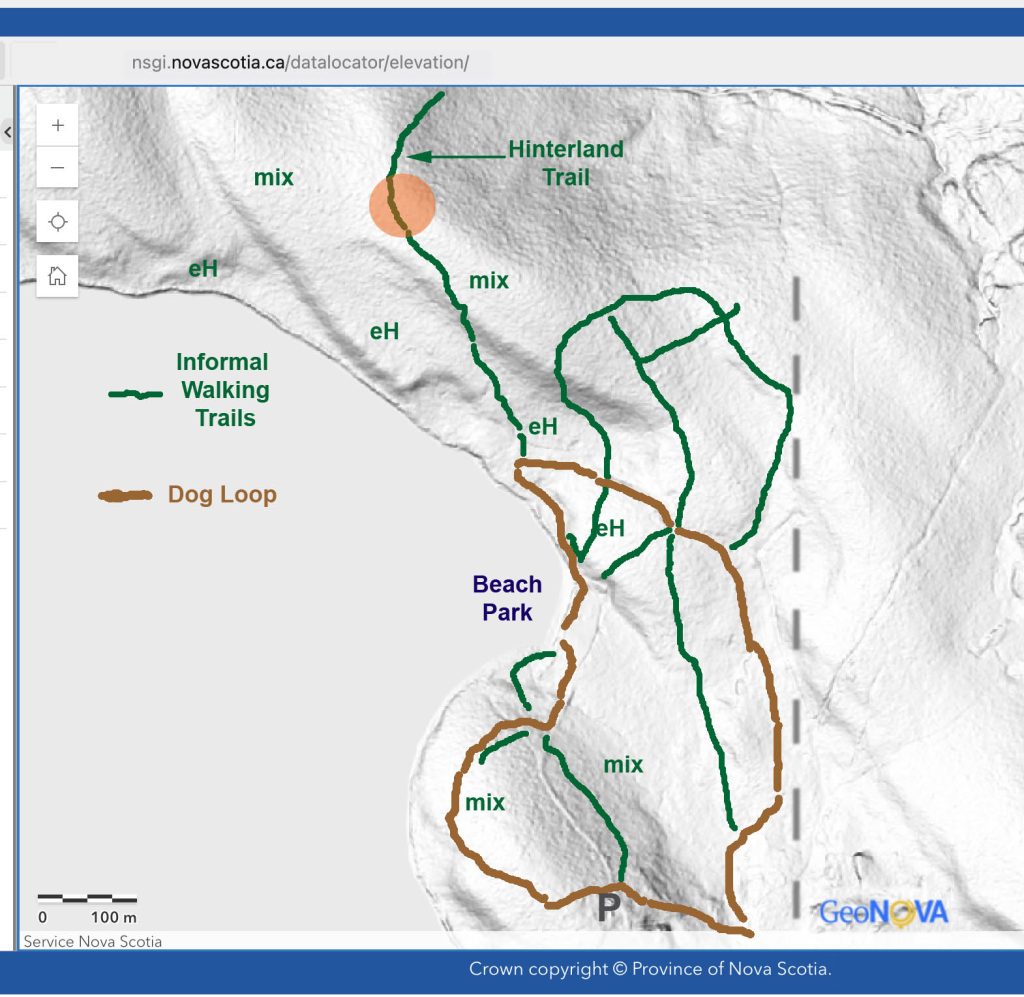
Rough Map of trails in the area of Sandy Lake beach (west of the broken line) superimposed on Lidar Image. Pale red circle shows vicinity of the “HWA Tree” (2024 sighting). “eH”: hemlock dominated forest stands; “mix”:mixed forest stands, with some hemlock. P: Parking Lot.The “Dog Loop” is a popular dog-walking route, much of it on old forestry roads. Currently, most of the foot traffic on these trails is by people with dogs; they visit regularly and year-round. Fewer numbers of wilderness runners, nature folks and rogue Mt Bikers frequent some of the lesser-used routes. In summer, the beach park may be visited on occasion by large numbers; most beach visitors walk only short distances on the adjacent trails.
Mixed forest (red spruce, hemlock, yellow birch, sugar maple, red maple) occurs on the crest of the drumlin, hardwood dominated mixed forest on the slope towards the north, and hemlock dominated forest, including patches of Old Growth, on the slope of the drumlin down to Sandy Lake.* Hemlock dominated and mixed forest stands with hemlock occur to the north of Sandy Lake all the way to the banks of the Sackville River. View observations reported on iNaturalist for some examples of individual trees.
*Ground observations show there is more hemlock-dominated forest on the slope by the lake than indicated by the Forest Vegetation Layers in the Provincial Landscape Viewer Map, see graphic above.
What can we do to “Save Hemlocks at Sandy Lake”?
Clearly, HWA could have a massive impact on the forests at Sandy Lake & Environs. What’s being done to address the issue in NS, in HRM? What can individuals do?
In the longer term, it is hoped that introduction of “Natural Enemies” of HWA can be effective in keeping populations of the pests at levels low enough to allow hemlock to remain an important tree in NS forests and efforts are underway to make such introductions. However at best, it could take 10-20 years to do the necessary research, testing etc. and for any introduced natural enemies to become established – and possibly much longer. In the meantime HWA is on the move and infected stands are dying.
So the short to intermediate term strategy is to “buy as much time as we can” by (i) taking actions to reduce/slow spread of HWA to areas not currently infected, and (ii) protecting uninfected trees by use of pesticides injected into trees or sprayed on their base.
Because of the expense and possible negative ecological effects were it conducted on a large scale, protecting trees with pesticides is of necessity limited to a very small proportion of the total population of hemlocks (probably well under 0.1%). The treatments are effective for only circa 5 years, thus are generally not used until there is known to be HWA close enough to the target tree(s) that infection could be expected within 1-2 years.
Monitoring is key, even when pesticides are being used.
The key things to look out for*:
(i) Adult adelgid: white wool at base of needles. particularly on the younger growth fall to late spring
(ii) Yellowing of needles and thinning of crown in the upper portion of larger trees
*Cited on a NS Gov Pamphlet given to volunteers participating in a survey of hemlocks for HWA at Hemlock Ravine on May 4, 2025. Photo at right is of a specimen, mounted behind glass, shown,to the volunteers.
For more details & photos, view this page on the NS Hemlock Initiative website:
When and How to Detect HWA
If you view what you think is an infected twig or a suspicious tree or set of trees, photograph them as you can, determine the location as closely as poss. and report your observations vis 311, the Nova Scotia Invasive Species Council or the Canadian Food Inspection Agency*
Slowing spread: Halifax Regional Municiaplity* advises the following:
- Avoid hanging bird feeders on or near hemlock trees
- Purchase firewood locally
- Buy hemlock trees from local suppliers and inspect trees carefully before purchasing
- Use a lint brush on your clothes and a bristled brush on shoes when moving from one forest stand to another
*As cited on HRM webpage, Hemlock woolly adelgid in the Halifax Regional Municipality.
The last mentioned item – cleaning clothes and shoes – is especially important after walking the forests at Sandy Lake given the recent sighting of HWA.
Likewise, we need many eyes looking out for signs of its occurrence in those forests. It’s really not very complicated, even just stopping and quickly inspecting undersides of hemlocks branches as you walk under or by them can help. To gain some experience and confidence in your observational skills, it can be helpful to participate on one of HRMs volunteer HWA surveys – those will be listed on the NS Hemlock Initiative Welcome Page along with other related workshops and events around the province.
For more info on HWA in Nova Scotia and HRM, see
– NS Hemlock Initiative
– Hemlock woolly adelgid in the Halifax Regional Municipality
Page posted May 20, 2020 by David Patriquin
